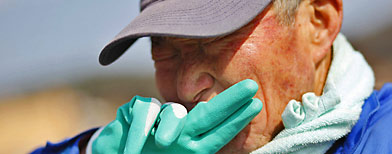
 Reuters – Shigemasa Kanno, 74, holds a photograph of his missing 68-year-old wife Sueko Kanno, at the debris of …
Reuters – Shigemasa Kanno, 74, holds a photograph of his missing 68-year-old wife Sueko Kanno, at the debris of … RIKUZENTAKATA, Japan (Reuters) – In a devastated landscape of splintered homes, rotting bodies and twisted cars, an elderly man walks with stooped shoulders searching for any object that can bring back memories of his daughter.
"Her home used to be there but that is gone," the man who asked to be called by his family name Kikuchi said, pointing at a spot in the town of Rikuzentakata, leveled by the tsunami of nearly two weeks ago.
"My daughter is missing. She is gone. I was up in the hills above town and couldn't get to her in time," Kikuchi said in a steady voice.
"I am looking for something that can remind me of her. There must be something here," Kikuchi said and then resumed wandering through the mud-strewn debris in the town of broken buildings erased by a giant wall of water.
The tsunami took just about everything from those in its path who escaped with just the clothes on their backs, as the wall of water destroyed homes, pictures, keepsakes and all the objects that are touchstones of memories.
People who have spent decades in these northeastern coastal towns now find themselves disoriented when they return because streets have vanished and landmarks disappeared.
In Ofunato, a middle-aged couple looked shell-shocked as they walked around for the first time since the quake to what used to be their neighborhood -- now a flat stretch of overturned trucks, splintered wood pieces from houses and crushed roofs.
"There is absolutely nothing left. I got in my car after the tsunami warning, thinking I would come back. I didn't have my wallet or my insurance card," the wife said.
She was clutching a wine opener she fond where her home used to be. "This was the only thing I could find in there."
The March 11 earthquake and tsunami left at least 21,000 people dead or missing and thousands homeless.
EVACUATION CENTRES
Almost all of the survivors are at evacuation shelters near their former homes sleeping in places such as cramped school gymnasiums, not far from message boards covered with requests seeking information on the missing and schedules for buses running to the morgue for body identification.
During the day, some venture back to where they once lived to survey the damage and perhaps salvage a few items. Many want to see the towns rebuilt, also asking themselves if they want to return.
Firefighters dispatched from Sakura, near Tokyo, pasted messages on their helmets with yellow and red reflective tape reading "Fight Iwate" and sifted through debris searching for bodies and collecting photos from the wreckage they hope to return to victims.
"All that I have left of my home is a hole with debris from somebody else's home," said Yasuo Koshita in the flattened town of Otsuchi.
He escaped by fleeing to a nearby hill and watched the tsunami roll through the town, churning up cars and homes in a black soup of destruction that deposited items haphazardly when the water finally retreated.
"This rail line came from that embankment across the way. The roof from the pump station ended up over there about 500 meters away and I have no idea what happened to these three big trees down the road that were more than 100 years old."
Koshita said he had a false sense of security living near a wall to protect the town from a tsunami but it was of no use when the wave hit.
"We are nestled in the mountains with the sea nearby and a river that flowed through town. The fishing was wonderful and it was peaceful," he said.
"This used to be such a beautiful place."
(Editing by Sugita Katyal)
 Play Video Earthquakes Video:American Teacher Found Dead in Japan ABC News
Play Video Earthquakes Video:American Teacher Found Dead in Japan ABC News  Play Video Earthquakes Video:Japan teen speaks of survival Reuters
Play Video Earthquakes Video:Japan teen speaks of survival Reuters  Play Video Earthquakes Video:Miracle quake survivor relieved to be rescued AP
Play Video Earthquakes Video:Miracle quake survivor relieved to be rescued APhttp://news.yahoo.com/s/nm/us_quake_japan_victims
No comments:
Post a Comment